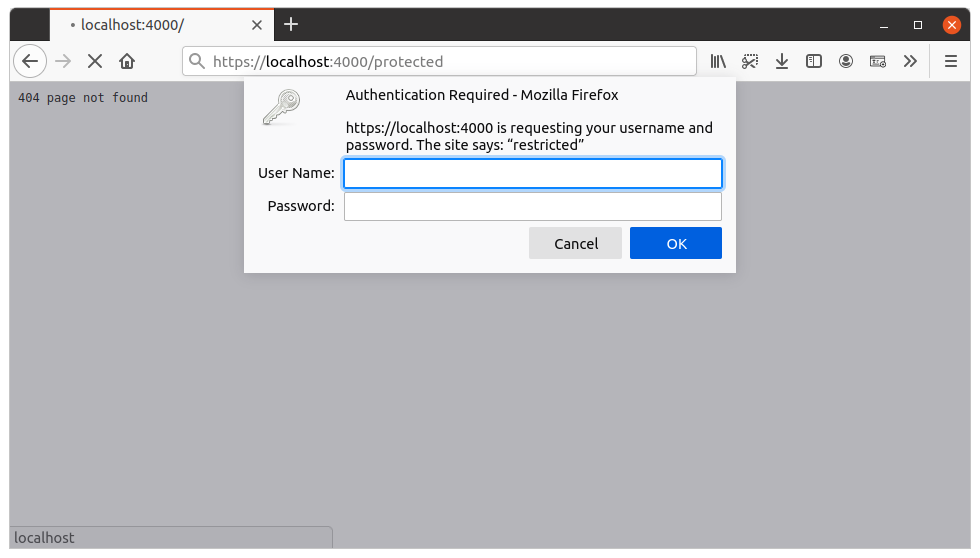Not sure how to structure your Go web application?
My new book guides you through the start-to-finish build of a real world web application in Go — covering topics like how to structure your code, manage dependencies, create dynamic database-driven pages, and how to authenticate and authorize users securely.
Take a look!
When searching for examples of HTTP basic authentication with Go, every result I found unfortunately contained code which was either out-of-date (i.e. doesn't use the r.BasicAuth() functionality that was introduced in Go 1.4) or failed to mitigate the risk of timing attacks.
So in this post, I'd like to discuss how to use it correctly in your Go applications.
We'll start with a bit of background information, but if you're not interested in that you can skip straight to the code.
What is basic authentication? When should I use it?
As a developer, you're probably already familiar with the prompt that web browsers show when you visit a URL that is protected with basic authentication.

When you input a username and password into this prompt, the web browser will send a HTTP request to the server containing an Authorization header — similar to this:
Authorization: Basic YWxpY2U6cGE1NXdvcmQ=
The Authorization header value is made up of the string Basic followed by the username and password in the format username:password and base-64 encoded. In this specific example, YWxpY2U6cGE1NXdvcmQ= is the base-64 encoding of the value alice:pa55word.
When the server receives this request, it can decode the username and password from the Authorization header and check that they are valid. If the credentials are not valid, the server can return a 401 Unauthorized response and the browser can redisplay the prompt.
Basic authentication can be used in lots of different scenarios, but it's often a good fit for when you have a low-value resource and want a quick and easy way to protect it from prying eyes.
To help keep things secure you should:
-
Only ever use it over HTTPS connections. If you don't use HTTPS, the
Authorizationheader can potentially be intercepted and decoded by an attacker, who can then use the username and password to gain access to your protected resources. -
Use a strong password that is difficult for attackers to guess or brute-force.
-
Consider adding rate limiting to your application, to make it harder for an attacker to brute-force the credentials.
On the client side, basic auth is supported out-of-the-box by most programming languages and command-line tools such as curl and wget, as well as web browsers.
Protecting a web application
Probably the simplest way to use basic authentication in your application is to create some middleware. In this middleware we want to do two things:
-
Extract the provided username and password from the request
Authorizationheader, if it exists. The best way to do this is with ther.BasicAuth()method. -
Compare the provided username and password against the values that you expect. If the username and password are not correct, or the request didn't contain a valid
Authorizationheader, then the middleware should send a401 Unauthorizedresponse and set aWWW-Authenticateheader to inform the client that basic authentication should be used to gain access. Otherwise, the middleware should allow the request to proceed and call the next handler in the chain.
When comparing the provided username and password against the expected values, to eliminate the risk of a timing attack you should use Go's subtle.ConstantTimeCompare() function instead of the == operator.
It's also important to be aware that using subtle.ConstantTimeCompare() can leak information about username and password length. To prevent this, we should hash both the provided and expected username and password values using a fast cryptographic hash function like SHA-256 before comparing them. This ensures that both the provided and expected values that we are comparing are equal in length and prevents subtle.ConstantTimeCompare() itself from returning early.
Putting that together, the pattern for implementing some middleware looks like this:
func basicAuth(next http.HandlerFunc) http.HandlerFunc {
return http.HandlerFunc(func(w http.ResponseWriter, r *http.Request) {
// Extract the username and password from the request
// Authorization header. If no Authorization header is present
// or the header value is invalid, then the 'ok' return value
// will be false.
username, password, ok := r.BasicAuth()
if ok {
// Calculate SHA-256 hashes for the provided and expected
// usernames and passwords.
usernameHash := sha256.Sum256([]byte(username))
passwordHash := sha256.Sum256([]byte(password))
expectedUsernameHash := sha256.Sum256([]byte("your expected username"))
expectedPasswordHash := sha256.Sum256([]byte("your expected password"))
// Use the subtle.ConstantTimeCompare() function to check if
// the provided username and password hashes equal the
// expected username and password hashes. ConstantTimeCompare
// will return 1 if the values are equal, or 0 otherwise.
// Importantly, we should do the work to evaluate both the
// username and password before checking the return values to
// avoid leaking information.
usernameMatch := (subtle.ConstantTimeCompare(usernameHash[:], expectedUsernameHash[:]) == 1)
passwordMatch := (subtle.ConstantTimeCompare(passwordHash[:], expectedPasswordHash[:]) == 1)
// If the username and password are correct, then call
// the next handler in the chain. Make sure to return
// afterwards, so that none of the code below is run.
if usernameMatch && passwordMatch {
next.ServeHTTP(w, r)
return
}
}
// If the Authentication header is not present, is invalid, or the
// username or password is wrong, then set a WWW-Authenticate
// header to inform the client that we expect them to use basic
// authentication and send a 401 Unauthorized response.
w.Header().Set("WWW-Authenticate", `Basic realm="restricted", charset="UTF-8"`)
http.Error(w, "Unauthorized", http.StatusUnauthorized)
})
}
You might also be wondering what the realm value is and why we are setting it to "restricted" in the WWW-Authenticate response header.
Basically, the realm value is a string which allows you to create partitions of protected space in your application. So, for example, an application could have a "documents" realm and an "admin area" realm, which require different credentials. A web browser (or other type of client) can cache and automatically reuse the same username and password for any requests within the same realm, so that the prompt doesn't need to be shown for every single request.
If you don't require multiple partitions for your application, you can set the realm to a single hardcoded value like "restricted", like we have in the code above.
For the sake of security and/or flexibility, you may also prefer to store the expected username and password values in environment variables or pass them as command-line flag values when starting the application, rather than hard-coding them into your application.
A working example
Let's take a quick look at this in the context of a small — but fully functioning — web application.
If you'd like to follow along, create a new basic-auth-example directory on your computer, add a main.go file, initialize a module, and create a pair of locally-trusted TLS certificates using the mkcert tool. Like so:
$ mkdir basic-auth-example
$ cd basic-auth-example
$ touch main.go
$ go mod init example.com/basic-auth-example
go: creating new go.mod: module example.com/basic-auth-example
$ mkcert localhost
Created a new certificate valid for the following names 📜
- "localhost"
The certificate is at "./localhost.pem" and the key at "./localhost-key.pem" ✅
It will expire on 21 September 2023 🗓
$ ls
go.mod localhost-key.pem localhost.pem main.go
Then add the following code to the main.go file, so that the application reads the expected username and password from environment variables and uses the middleware pattern that we described above.
package main
import (
"crypto/sha256"
"crypto/subtle"
"fmt"
"log"
"net/http"
"os"
"time"
)
type application struct {
auth struct {
username string
password string
}
}
func main() {
app := new(application)
app.auth.username = os.Getenv("AUTH_USERNAME")
app.auth.password = os.Getenv("AUTH_PASSWORD")
if app.auth.username == "" {
log.Fatal("basic auth username must be provided")
}
if app.auth.password == "" {
log.Fatal("basic auth password must be provided")
}
mux := http.NewServeMux()
mux.HandleFunc("GET /unprotected", app.unprotectedHandler)
mux.HandleFunc("GET /protected", app.basicAuth(app.protectedHandler))
srv := &http.Server{
Addr: ":4000",
Handler: mux,
IdleTimeout: time.Minute,
ReadTimeout: 10 * time.Second,
WriteTimeout: 30 * time.Second,
}
log.Printf("starting server on %s", srv.Addr)
err := srv.ListenAndServeTLS("./localhost.pem", "./localhost-key.pem")
log.Fatal(err)
}
func (app *application) protectedHandler(w http.ResponseWriter, r *http.Request) {
fmt.Fprintln(w, "This is the protected handler")
}
func (app *application) unprotectedHandler(w http.ResponseWriter, r *http.Request) {
fmt.Fprintln(w, "This is the unprotected handler")
}
func (app *application) basicAuth(next http.HandlerFunc) http.HandlerFunc {
return http.HandlerFunc(func(w http.ResponseWriter, r *http.Request) {
username, password, ok := r.BasicAuth()
if ok {
usernameHash := sha256.Sum256([]byte(username))
passwordHash := sha256.Sum256([]byte(password))
expectedUsernameHash := sha256.Sum256([]byte(app.auth.username))
expectedPasswordHash := sha256.Sum256([]byte(app.auth.password))
usernameMatch := (subtle.ConstantTimeCompare(usernameHash[:], expectedUsernameHash[:]) == 1)
passwordMatch := (subtle.ConstantTimeCompare(passwordHash[:], expectedPasswordHash[:]) == 1)
if usernameMatch && passwordMatch {
next.ServeHTTP(w, r)
return
}
}
w.Header().Set("WWW-Authenticate", `Basic realm="restricted", charset="UTF-8"`)
http.Error(w, "Unauthorized", http.StatusUnauthorized)
})
}
You should then be able to start the application, using a pair of temporary AUTH_USERNAME and AUTH_PASSWORD environment variables. Like so:
$ AUTH_USERNAME=alice AUTH_PASSWORD=p8fnxeqj5a7zbrqp go run .
2021/06/20 16:09:21 starting server on :4000
At this point, if you open your web browser and visit https://localhost:4000/protected you should be greeted by the basic authentication prompt.
Alternatively, you can make some requests using curl to verify that the authentication checks are working correctly.
$ curl -i https://localhost:4000/unprotected
HTTP/2 200
content-type: text/plain; charset=utf-8
content-length: 32
date: Sun, 20 Jun 2021 14:09:56 GMT
This is the unprotected handler
$ curl -i https://localhost:4000/protected
HTTP/2 401
content-type: text/plain; charset=utf-8
www-authenticate: Basic realm="restricted", charset="UTF-8"
x-content-type-options: nosniff
content-length: 13
date: Sun, 20 Jun 2021 14:09:59 GMT
Unauthorized
$ curl -i -u alice:p8fnxeqj5a7zbrqp https://localhost:4000/protected
HTTP/2 200
content-type: text/plain; charset=utf-8
content-length: 30
date: Sun, 20 Jun 2021 14:10:14 GMT
This is the protected handler
$ curl -i -u alice:wrongPa55word https://localhost:4000/protected
HTTP/2 401
content-type: text/plain; charset=utf-8
www-authenticate: Basic realm="restricted", charset="UTF-8"
x-content-type-options: nosniff
content-length: 13
date: Sun, 20 Jun 2021 14:15:30 GMT
Unauthorized
Making a request to a protected resource
Finally, if you need to access a protected resource from your Go code as a client, all you need to do is call the r.SetBasicAuth() method on your request before executing it. Like so:
package main
import (
"fmt"
"io"
"log"
"net/http"
"time"
)
func main() {
client := http.Client{Timeout: 5 * time.Second}
req, err := http.NewRequest(http.MethodGet, "https://localhost:4000/protected", http.NoBody)
if err != nil {
log.Fatal(err)
}
req.SetBasicAuth("alice", "p8fnxeqj5a7zbrqp")
res, err := client.Do(req)
if err != nil {
log.Fatal(err)
}
defer res.Body.Close()
resBody, err := io.ReadAll(res.Body)
if err != nil {
log.Fatal(err)
}
fmt.Printf("Status: %d\n", res.StatusCode)
fmt.Printf("Body: %s\n", string(resBody))
}
If you enjoyed this post...
You might like to check out my other Go tutorials on this site, or if you're after something more structured, my books Let's Go and Let's Go Further cover how to build complete, production-ready, web apps and APIS with Go.